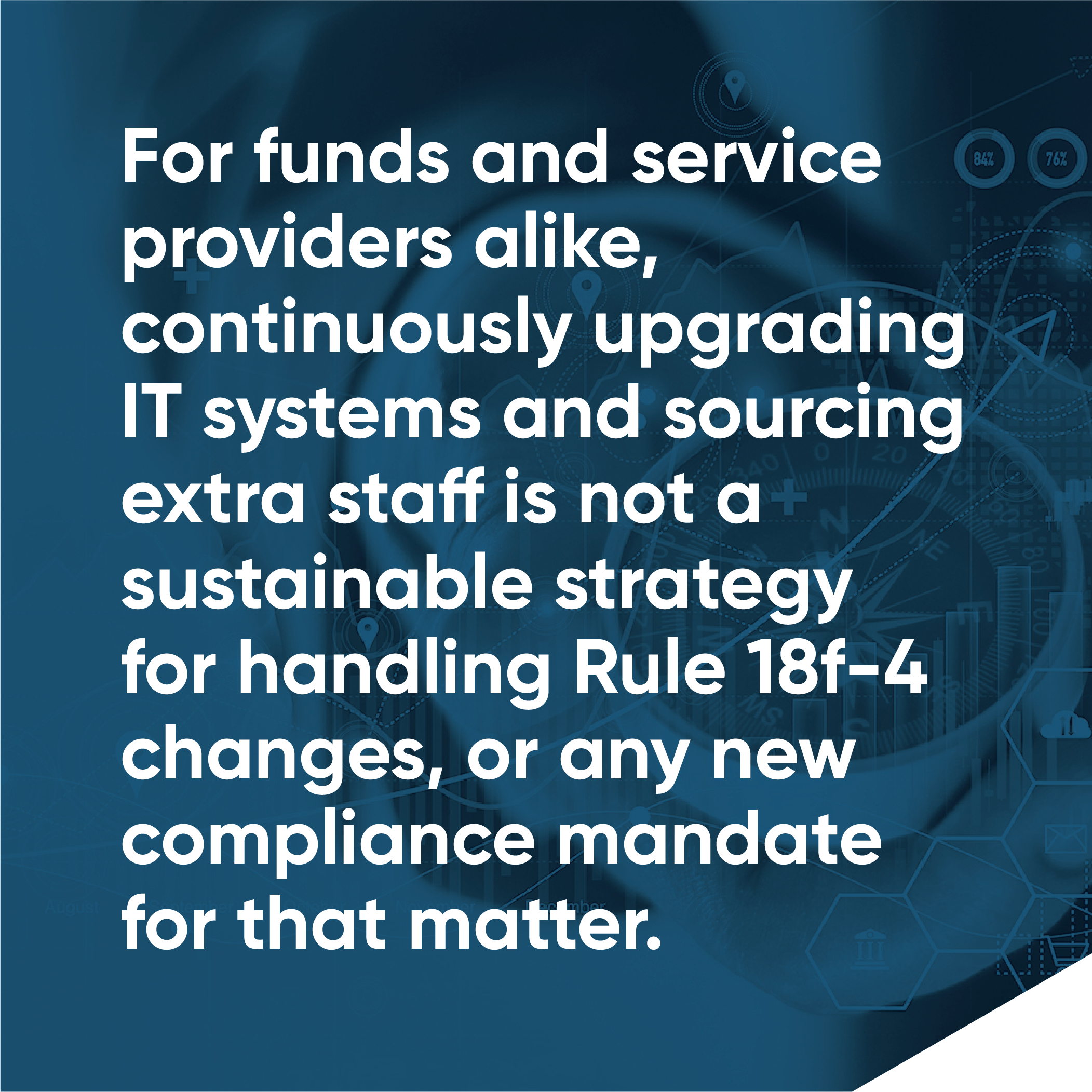A derivative is a financial instrument whose price is based entirely on something else. And in the separation between price and the underlying asset, things can get complicated and risky. That’s why – for as long as derivatives have existed – those in charge have tried to control their use with laws and regulations.The electronification of trading in the past couple of decades has revolutionized the industry, leaving regulators in a constant struggle to keep up. To modernize the regulatory framework covering derivatives, and to address how both derivatives themselves – and the risks they pose to investors – have changed, the SEC has fundamentally changed the rules.
Those new rules were outlined by the SEC in an October 2020 press release that announced the adoption of Rule 18f-4. This new derivatives risk management rule significantly changes how derivatives and certain related transactions need to be handled by regulated funds, including mutual funds (other than money market funds), exchange-traded funds (ETFs), closed-end funds and business development firms. In our latest article, “Adapting Smoothly to SEC Rule 18f-4,” we examine the details of this rule and their implications for asset managers.
 This rule change replaces a decades-old system that was confusing and, at times, even contradictory. The rule took effect on February 19, 2021, but the SEC has given funds a compliance transition period of 18 months. That means funds have until mid-August of 2022 to demonstrate that they are aligned with the new regime.
This rule change replaces a decades-old system that was confusing and, at times, even contradictory. The rule took effect on February 19, 2021, but the SEC has given funds a compliance transition period of 18 months. That means funds have until mid-August of 2022 to demonstrate that they are aligned with the new regime.
At a high level, the rule allows a fund to enter into “derivatives transactions” provided that it complies with restrictions on the issuance of “senior securities”. Rule 18f-4 places limits on funds’ use of leverage and establishes new, derivatives-focused risk management and reporting requirements.
For everyone affected by this SEC rule change, including mutual funds, ETFs, closed-end funds, in-house governance and compliance groups, and outsourced service providers, the goal is the same: adapting whatever regulatory reporting approach or platform they are currently using to accommodate the change.
Challenges arise as firms and funds try to minimize the operational disruption and additional costs these regulatory changes can cause. For funds and service providers alike, continuously upgrading IT systems and sourcing extra staff is not a sustainable strategy for handling Rule 18f-4 changes, or any new compliance mandate for that matter. What funds need instead is adaptability in their compliance and reporting programs.
Given how strongly the industry is moving to the cloud, the right answer isn’t making another change to a legacy system. Nor is it buying another narrowly focused “point” solution that may help in the short term but ultimately will bog down the program with more complexity and administrative overhead. The good news is that a better, smarter approach is available. It provides a way for funds to get past legacy inefficiencies by digitizing their risk and compliance reporting requirements, saving time and money while providing more accurate and timely intelligence to all who require it.
The core capabilities required for achieving compliance agility are twofold: flexible data automation and customizable analytics. Firms and service providers can make the investments needed to create these specialized, compliance-centric capabilities in-house. Alternatively, they can accelerate the process by engaging with a trustworthy vendor. That technology partner must have market-tested technology and expertise, along with a track record of success in helping clients to up their compliance game with more effective and adaptable compliance data collection, analysis and reporting. This is a perfect description of Confluence. A global leader in data-driven investment management technologies, Confluence helps clients turn data into financial intelligence and optimize their processes with efficiency and control. Our award-winning solutions address a range of performance and analytics and risk needs.
One strong area of focus is coupling data automation with powerful analytics to provide a complete framework around the risk management process via the Confluence Revolution platform, including advanced regulatory compliance monitoring and investor reporting solutions. It automates and optimizes reporting via regulatory forms with configurable content and form-specific calculations, which enable more accurate analyses, faster collaboration, more user-friendly editing and report generation and easier dissemination.
How does our experience relate to the challenges of complying with the new Rule 18f-4? The answer is that this is an existing capability for us – we will be ready to go well ahead of the August 2022 enforcement start. While this rule represents new regulatory guidance for the U.S., we have been helping our clients in Europe meet similar requirements for years.
Accommodating new regulatory requirements in complex investment workflows, processes and systems today is far more difficult today than in years past. Confluence, with its Revolution Platform and advanced risk and compliance functionality, provides clients with an easy, market-tested and proven path to solid Rule 18f-4 compliance. Using Revolution’s industry-leading technology, backed by Confluence’s expert staff, clients can adapt to 18f-4’s changes without missing a beat.
Disclaimer: The information contained in this communication is for informational purposes only. Confluence/StatPro is not providing, legal, financial, accounting, compliance or other similar services or advice through this communication. Recipients of this communication are responsible for understanding the regulatory and legal requirements applicable to their business.